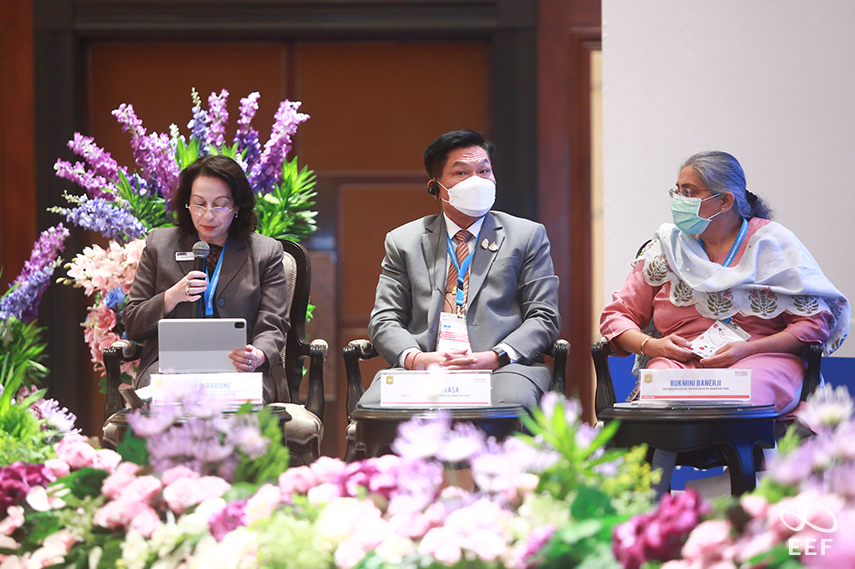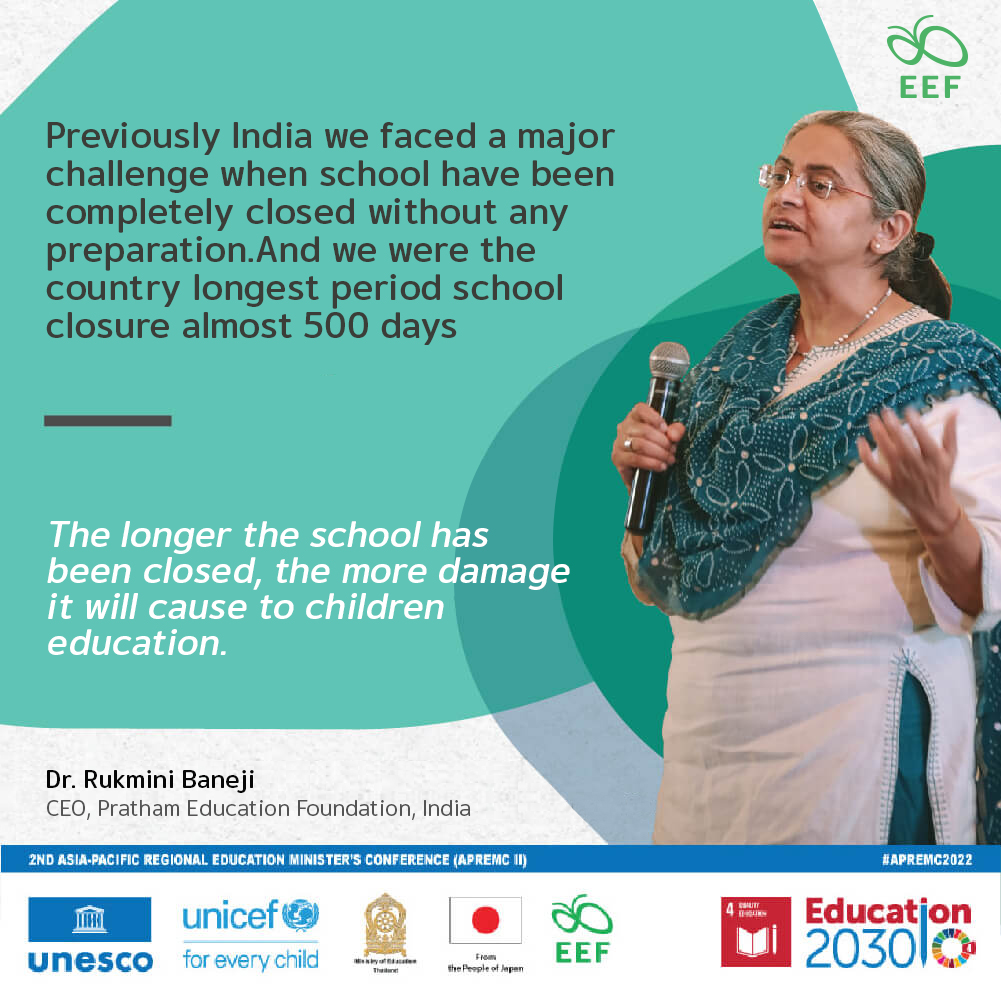
Session: 1 Learning Recovery and Addressing the Learning Crisis in the Asia-Pacific Region
Covid-19 reveals the underdevelopment of children around Asia due to severe educational inequity that needs to be recovered urgently.
The COVID-19 pandemic situation greatly affected the education of more than 1.2 billion students in the Asia-Pacific region as the schools were closed down throughout the region. The situation has transformed the school system into a remote learning platform that even worsened educational inequity.
As educational systems in the Asia Pacific are struggling to recover from educational loss caused by the pandemic and handling the educational crisis on a large scale, the governments need to come up with an effective recovery strategy and support the educational transformation to ensure that students will be proficient in numeracy and reading and develop themselves to their full potential as well as the society and economy in the future.

The 2nd Asia Pacific Regional Education Minister’s Conference Session 2 was held on June 5th, 2022 at the Shangri-La Hotel to review the progress of the Sustainable Development Goal 4 – SDG4 for the Asia-Pacific. It indicates that after the overall improvement, most of the countries in the region are still far from achieving the SDG4 goal both in terms of literacy and numeracy. This education crisis occurred before the COVID-19 pandemic situation when 53% of 10-year-old children in poor/average households in the countries were still unable to read and had very slow learning progress.
As the COVID-19 pandemic situation forced schools to be closed down entirely, the educational systems were suspended for 2 years and the education crisis got worse than it was before the pandemic. In 2019, over 80% of primary school students in the Asia-Pacific had reading and numeracy skills lower than the standard and failed to achieve the learning objectives. The crisis led millions of students to drop out of school because of having low reading and numeracy skills.
Margarete Sachs-Israel, Head of Education Quality, UNESCO Asia and Pacific Regional Bureau for Education stated that the Southeast Asia Primary Learning Measurement (SEA-PLM) in 2019 indicated that only 2 out of 6 Southeast Asian countries had more than half of students who graduated from primary school with standard reading and numeracy skills.
Likewise, the Pacific Islands Literacy and Numeracy Assessment (PILNA) 2018 indicates that of all 15 participating nations, on average, less than 14% of the children had numeracy skills that meet the standard and less than 17% had reading skills that meet the standard after graduating primary school (Australian Council for Education Research (ACER), 2019).
Dr. Baela Jamil – CEO, Idara-e-Taleem-o-Aagahi (ITA) or the Center of Education and Consciousness, Pakistan stated that the educational crisis was still present in 3, 5 grades and junior high school levels where help was urgently needed from the basics. In 2021, we conducted a learning assessment (SEA-PLM Assessment) for 5-16- year-old children and compared the results with 2019. We found that the “number of children with literacy and numeracy skills has decreased by 4% in grade 5 and by 8% in junior high schools.” We were aware that this was an educational loss caused by the pandemic. We needed to pay attention to it urgently because the impact would spread wider if not solved or recovered urgently.

Dr. Rukmini Baneji – CEO, Pratham Education Foundation, India stated that “before we build innovations, we need to be sure of their effectiveness.” We need to set guidelines based on the crisis in India. We faced a major challenge when schools were closed down without any preparations. We were the country where schools were closed down for the longest period of almost 500 days. The longer the closed-down period was, the more education loss it caused, especially for children in remote areas and underprivileged households who already struggled to go to school even before the crisis.
We would like everyone to be aware that “grade 1 and 2 students are very important as they reflect our future.” Now schools have been reopened and children have begun to return to school. But grade 3 students and higher will need to catch up with the course schedule until they enter a university.

Dr. Umporn Pinasa, Permanent Secretary of Basic Education Commission (SorPorThor.) stated that Thailand’s educational system was affected by the COVID-19 pandemic situation as same as other nations around the world. Educational inequity was found to consist of 3 elements as below.
- Geographical element – Remote areas and border areas.
- Household financial status – The gap between the poor and the rich greatly increases educational inequality.
- School size – Big and small sizes.
Despite educational inequality, the government is committed to improving and focusing on educational equity to ensure that everyone from every area has access to education, especially in remote areas where internet and telephone signals are not available, in order to reduce educational inequality.
From the situation, the government has shifted the learning system to a blended learning approach and improved the curriculums to suit the learning ability of students by emphasizing active learning and evaluations with the main goal to make education accessible to all Thai citizens regardless of the area to reduce educational inequity.
Thailand follows the idea of the late king Bhumibol Adulyadej (Rama 9) by providing remote learning through satellite (DLTV) to solve the problems of small schools. The system support teaching from preschool to senior high school. Now schools have been reopened and the teaching has been conducted onsite 100%. The lesson learned from the pandemic is that “education truly needs the participation of everyone.”
After schools have been reopened for 2-3 weeks, we have discovered problems of students that need to be solved as below.
- Social – Students are unable to adjust themselves to others in the school.
- Health and sanitary – We need to monitor and supervise regularly.
- Learning ability – The Office of Basic Education Commission (SorPorThor.) has announced its policy for the first 3 months to avoid expediting the progress of the 8 core subjects and evaluate the readiness of students in 3 aspects (1) physical (health) (2) emotional and social reaction (3) education background.
After the evaluation, students will be provided with what they need to be ready so that they will enjoy studying before we begin to emphasize Thai and mathematics subjects in grades 1 – 3.
“Without literacy or numeracy skills, children will lack what they need to progress in life” – Dr. Umporn Pinasa, Permanent Secretary of Basic Education Commission (SorPorThor.).
Dr. Pina Tarricone, Head Researcher and Head of the Australia Council for Educational Research (ACER) concluded that the COVID-19 pandemic situation increased educational inequity in which students in remote areas were most affected due to the lack of access to technology and quality education. Moreover, the pandemic also affected society and gender discrimination apart from educational inequity in some countries such as Bangladesh and Pakistan where families were willing to support boys in education rather than girls who were forced to leave the school system, get married, and get pregnant before coming of age. This issue also increased family and sexual violence.
Ethel Agnes P. Valenzuela, Director, SEAMEO Secretariat, the host of the conference stated that we have learned a lot from the COVID-19 pandemic situation. As we know, we were there to find the best learning recovery and guidelines for children and relevant people after 2 years that more than 1.6 billion people suffered, could not adjust themselves to the new normal and lost almost half a year of education. So, we have prepared recovery policy indicators as below.
- Evaluate the ability to learn, understand, and handle the emotion of each student in order to plan different teaching approaches.
- Adjust the courses by prioritizing essential basic skills and subjects of each class and extend teaching time or adjust the course schedule as needed in order to monitor properly.
- Execute the education recovery strategy by preparing and supporting teachers and students who are outside the school system to improve their teaching proficiency with ICT technology, blended teaching techniques, digital technology, accessible content and better living conditions.
- Provide psychosocial support, good living conditions, and a safe school environment for all students to recover.
Solutions for Learning Crisis (Roles of the courses and evaluation in changing the education system)
- Design new courses in which students learn basic digital skills, 21st-century skills, social/emotional skills, Educational Sustainability Development (ESD), Global Citizenship Education (GCED), and real-world professional skills.
- Transform the courses to the Whole-Child Approach and facilitate multi-domain learning (skills/attitude/value) based on the principle of participation, unity, and lifetime learning.
- Provide effective evaluation (conclusive and systematic) to improve learning and avoid regressive/high-stake tests.
- Determine clear learning achievement indicators, provide regional/national performance tests to monitor learning results and announce learning policy changes and guidelines.
- Implement the blended learning approach for all students and encourage preparedness and flexibility in schools/educational institutions in case of emergencies and future pandemics.
- Promote cooperation among families, communities and authorities and provide advice on collaboration.
- Solve the education crisis caused by migration and support lossless education.

